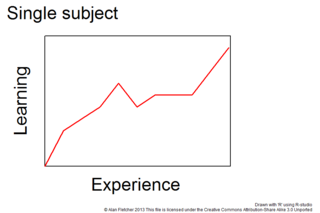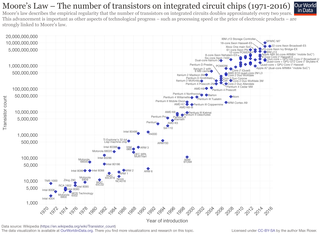In genetics and biochemistry, sequencing means to determine the primary structure of an unbranched biopolymer. Sequencing results in a symbolic linear depiction known as a sequence which succinctly summarizes much of the atomic-level structure of the sequenced molecule.
The technological singularity is the hypothesis that the invention of artificial superintelligence (ASI) will abruptly trigger runaway technological growth, resulting in unfathomable changes to human civilization.

The Macintosh Plus computer is the third model in the Macintosh line, introduced on January 16, 1986, two years after the original Macintosh and a little more than a year after the Macintosh 512K, with a price tag of US$2599. As an evolutionary improvement over the 512K, it shipped with 1 MB of RAM standard, expandable to 4 MB, and an external SCSI peripheral bus, among smaller improvements. It originally had the same generally beige-colored case as the original Macintosh, but in 1987, the case color was changed to the long-lived, warm gray "Platinum" color. It is the earliest Macintosh model able to run System 7 OS.
Rambus DRAM (RDRAM), and its successors Concurrent Rambus DRAM (CRDRAM) and Direct Rambus DRAM (DRDRAM), are types of synchronous dynamic RAM developed by Rambus from the late-1980s through to the early-2000s. The third-generation of Rambus DRAM, DRDRAM was replaced by XDR DRAM. Rambus DRAM was developed for high-bandwidth applications, and was positioned by Rambus as replacement for various types of contemporary memories, such as SDRAM.

Exponential growth is exhibited when the rate of change—the change per instant or unit of time—of the value of a mathematical function of time is proportional to the function's current value, resulting in its value at any time being an exponential function of time, i.e., a function in which the time value is the exponent.
Exponential decay occurs in the same way when the growth rate is negative. In the case of a discrete domain of definition with equal intervals, it is also called geometric growth or geometric decay, the function values forming a geometric progression. In either exponential growth or exponential decay, the ratio of the rate of change of the quantity to its current size remains constant over time.
In management, models of the learning curve effect and the closely related experience curve effect express the relationship between equation and efficiency or between efficiency gains and investment in the effort.

A learning curve is a graphical representation of how an increase in learning comes from greater experience ; or how the more someone performs a task, the better they get at it.

A graphics processing unit (GPU) is a specialized electronic circuit designed to rapidly manipulate and alter memory to accelerate the creation of images in a frame buffer intended for output to a display device. GPUs are used in embedded systems, mobile phones, personal computers, workstations, and game consoles. Modern GPUs are very efficient at manipulating computer graphics and image processing. Their highly parallel structure makes them more efficient than general-purpose CPUs for algorithms that process large blocks of data in parallel. In a personal computer, a GPU can be present on a video card or embedded on the motherboard. In certain CPUs, they are embedded on the CPU die.

The PowerBook G3 is a series of laptop Macintosh personal computers designed, manufactured and sold by Apple Computer, Inc. from 1997 to 2001. It was the first laptop to use the PowerPC G3 (PPC740/750) series of microprocessors, and was marketed as the fastest laptop in the world for its entire production run. The PowerBook G3 was succeeded by the PowerBook G4.
Areal density is a measure of the quantity of information bits that can be stored on a given length of track, area of surface, or in a given volume of a computer storage medium. Generally, higher density is more desirable, for it allows more data to be stored in the same physical space. Density therefore has a direct relationship to storage capacity of a given medium. Density also generally affects the performance within a particular medium, as well as price.
In computer architecture, speedup is a number that measures the relative performance of two systems processing the same problem. More technically, it is the improvement in speed of execution of a task executed on two similar architectures with different resources. The notion of speedup was established by Amdahl's law, which was particularly focused on parallel processing. However, speedup can be used more generally to show the effect on performance after any resource enhancement.
In futures studies and the history of technology, accelerating change is a perceived increase in the rate of technological change throughout history, which may suggest faster and more profound change in the future and may or may not be accompanied by equally profound social and cultural change.

The Yamaha Motif is a series of music workstation synthesizers, first released by Yamaha Corporation in August 2001. The Motif replaced the EX series in Yamaha's line-up. Other workstations in the same class are the Korg Kronos and the Roland Fantom G.

The ATI Rage is a series of graphics chipsets offering GUI 2D acceleration, video acceleration, and 3D acceleration. It is the successor to the Mach series of 2D accelerators.

Random-access memory is a form of computer data storage that stores data and machine code currently being used. A random-access memory device allows data items to be read or written in almost the same amount of time irrespective of the physical location of data inside the memory. In contrast, with other direct-access data storage media such as hard disks, CD-RWs, DVD-RWs and the older magnetic tapes and drum memory, the time required to read and write data items varies significantly depending on their physical locations on the recording medium, due to mechanical limitations such as media rotation speeds and arm movement.

The Voodoo2 is a set of three specialized 3D graphics chips on a single chipset setup, made by 3dfx. It was released in February 1998 as a replacement for the original Voodoo Graphics chipset. The card runs at a chipset clock rate of 90 MHz and uses 100 MHz EDO DRAM, and is available for the PCI interface. The Voodoo2 comes in two models, one with 8 MB RAM and one with 12 MB RAM. The 8 MB card has 2 MB of memory per texture mapping unit (TMU) vs. 4 MB on the 12 MB model. The 4 MB framebuffer on both cards support a maximum screen resolution of 800 × 600, while the increased texture memory on the 12 MB card allows more detailed textures. Some boards with 8 MB can be upgraded to 12 MB with an additional daughter board.

Koomey's law describes a long-term trend in the history of computing hardware. The number of computations per joule of energy dissipated has been doubling approximately every 1.57 years. This trend has been remarkably stable since the 1950s and has been somewhat faster than Moore's law. Jonathan Koomey articulated the trend as follows: "at a fixed computing load, the amount of battery you need will fall by a factor of two every year and a half."
Engelbart's law is the observation that the intrinsic rate of human performance is exponential. The law is named after Douglas Engelbart, whose work in augmenting human performance was explicitly based on the realization that although we make use of technology,
the ability to improve on improvements resides entirely within the human sphere.
Virtual memory compression is a memory management technique that utilizes data compression to reduce the size or number of paging requests to and from the auxiliary storage. In a virtual memory compression system, paging requests are compressed and stored in physical memory, which is usually random-access memory (RAM), or sent as compressed to auxiliary storage such as a hard disk drive (HDD) or solid-state drive (SSD). In both cases the virtual memory range whose contents has been compressed during the paging request is marked inaccessible so that attempts to access compressed pages can trigger page faults and reversal of the process. The footprint of the data being paged is reduced by the compression process; in the first instance, the freed RAM is returned to the available physical memory pool, while the compressed portion is kept in RAM. In the second instance, the compressed data is sent to auxiliary storage but the resulting I/O operation is smaller and therefore takes less time.











